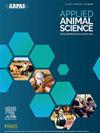A 12-year summary of the effects of estrous synchronization and body weight at breeding on reproductive success of Bos indicus-influenced beef heifers grazing warm-season grasses
IF 1.5
Q3 AGRICULTURE, DAIRY & ANIMAL SCIENCE
引用次数: 0
Abstract
Objective
The objective was to evaluate the effects of estrus synchronization and body weight before the start of breeding season on reproduction of Bos indicus-influenced beef heifers.
Materials and Methods
Data were collected from grazing, Brangus crossbred beef heifers (n = 594) weaned at 280 ± 26 d of age and fed concentrate from 2 wk after weaning until the end of the breeding season (189 ± 24 d of supplementation). Heifers were initially sorted into those that were (SYNC) and were not (NOSYNC) as- signed to an estrous synchronization protocol before the start of the breeding season. Then, within each synchro- nization group, heifers were sorted into those that were below (BE) or above (AB) 295 kg (65% of mature BW) at the start of the breeding season.
Results and Discussion
Effects of synchronization × BW at breeding and synchronization were not detected for growth performance, but tended to be detected for pu- berty attainment, which was the least for NOSYNC+BE, did not differ between SYNC+BE versus NOSYNC+AB, and was greatest for SYNC+AB heifers. Pregnancy and calving percentages were greater for AB versus BE heifers.
Implications and Applications
Results of this study indicate that Bos indicus-influenced beef heifers need to achieve ≥65% of mature BW at the start of the breeding season to optimize reproduction, whereas estrous synchro- nization protocols enhanced puberty attainment (regard- less of BW) and early calving distribution when heifers were <65% of mature BW at the start of the breeding season.
育期发情同步和体重对暖季牧草影响的肉牛繁殖成功的12年总结
目的评价发情同步和繁殖季节开始前体重对受母牛母牛病影响的肉牛繁殖的影响。材料与方法594头布兰格斯(Brangus)杂交肉牛(280±26日龄),从断奶后2周开始饲喂精料,直至繁殖季结束(补饲期189±24 d)。小母牛最初被分为(同步)和(非同步)两组,在繁殖季节开始前签署了发情同步协议。然后,在每个同步组中,将犊牛分为繁殖季节开始时体重低于(BE)或高于(AB) 295 kg(占成熟体重的65%)的组。结果与讨论育成期同步×体重对犊牛生长性能的影响不显著,但对犊牛肥力的影响显著,其中对NOSYNC+ be犊牛的影响最小,对NOSYNC+ be犊牛与NOSYNC+AB犊牛的影响不显著,对SYNC+AB犊牛的影响最大。AB型母牛的妊娠和产犊率高于BE型母牛。本研究结果表明,受母牛母牛病影响的肉牛在繁殖季节开始时需要达到≥65%的成熟体重才能优化繁殖,而发情同步方案提高了青春期的达到(不考虑体重)和早期产犊分布,当母牛在繁殖季节开始时达到成熟体重的65%时。
本文章由计算机程序翻译,如有差异,请以英文原文为准。
求助全文
约1分钟内获得全文
求助全文

 求助内容:
求助内容: 应助结果提醒方式:
应助结果提醒方式:


